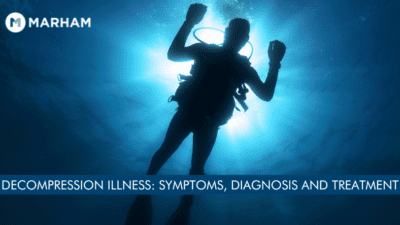You probably would not have heard about the caisson disease before but will be shocked to know that it is quite common. Also known, as the decompression illness, this disease takes the lives of many divers, aviators, and even astronauts.
Read everything related to the caisson disease from its symptoms to treatment options in this health blog.
About Caisson Disease:
The caisson disease or the decompression illness refers to the sicknesses brought on by a rapid drop in the pressure surrounding the body. It is most frequently seen in recreational or commercial diving today, but it can also affect aviators, astronauts, and others who deal with compressed air.
This condition is also known as the bends and is mainly caused by microscopic nitrogen bubbles. As divers ascend to the surface from the compressed air in the caisson, bubbles emerge from the solution in their blood.
The next time you open a bottle of Coke, you can witness this for yourself. The soda is under pressure in a closed bottle and the dissolved gas bubbles are too small to notice. The pressure drops when the container is opened, which causes the gas bubbles to expand and froth.
Caisson Disease History:
The history of Caison disease dates back to 1670. According to research, Sir Robert Boyle stuffed a snake inside an airtight container and quickly vacuumed out the air. The snake’s body and neck swelled prodigiously tumid, and a blister developed upon the back.
This finding would be considered the first description of decompression sickness. Despite the fact that humans have been submerged in the ocean for thousands of years, 19th-century technical developments allowed for deeper dives and a higher risk of injury from compressed air.
The first humans to experience the symptoms of inhaling compressed air in a mine were French miners in the 1840s. However, it wasn’t until two high-profile bridge constructions employing caissons for their foundations in the 1870s that the condition gained worldwide attention.
Caisson Disease Pronunciation:
Cais·son dis·ease is the pronunciation for caisson disease. It is also known as the Decompression illness.
Caisson Disease Symptoms:
The signs and symptoms of caisson disease can include:
- fatigue
- pain in muscles and joints
- numbness
- tingling
- arm or leg weakness
- unsteadiness
- spinning
- difficulty breathing
- chest pain
- Other signs include acute shock and a burning feeling while breathing.
People also report that the caisson disease symptoms also feel like having a stroke. In case, you notice any of these symptoms, see a doctor immediately. Click here to speak to an online doctor today via Marham.
Complications caused by the Caisson Disease:
The bubbles formed in caisson disease can cause the following problems or disorders in the body:
- Nervous system: brain, spinal cord, or peripheral nerves can cause paralysis and convulsions (divers’ palsy)
- Coordination system: problems with muscle coordination and sensory abnormalities like numbness, nausea, speech defects, and personality changes
- Joints: joint bubble accumulation often causes considerable discomfort and limited movement. Due to the widespread inability of the affected individual to straighten joints, the name “bends” is derived from this condition.
- Under the skin: Divers’ itches are a red rash and itchy feeling that can be brought on by tiny nitrogen bubbles that become trapped under the skin. These sensations often disappear in 10 to 20 minutes.
- Respiratory system: The chokes, or excessive coughing and breathing difficulties, are signs of nitrogen bubbles in the respiratory system.
Also, read about the Lumpy Skin Disease Outbreak
Caisson Disease Diagnosis:
According to research data, the caisson disease has different levels of severity and there is no definitive test you can conduct to diagnose it. One of the reasons is that it is difficult to measure inert gases and identify bubbles in tissue.
Caisson DiseaseTreatment:
Only progressive decompression followed by recompression in a hyperbaric chamber is often able to provide relief from decompression sickness, although this method is not always able to undo tissue damage.
Consult a Doctor today!
If you or someone you know has any of the symptoms listed above it is best to get a proper check-up. It can ensure recovery and improvement in the condition.
1
Can’t Find the App?
| Android | IOS |
|---|---|
  |
  |
FAQs
Why is it called caisson disease?
The usage of caissons under pressure to prevent flooding of significant engineering excavations beneath a water table, such as bridge supports and tunnels, led to the invention of this phrase in the 19th century.
What causes decompression sickness?
When dissolved gases (often nitrogen or helium used in mixed gas diving) escape the solution and create bubbles inside the body on depressurization, decompression sickness ensues.
What are the caisson disease symptoms?
The symptoms of caisson disease can include fatigue, numbness, pain in muscles and joints, tingling, arm or leg weakness, spinning, difficulty breathing, and chest pain.

